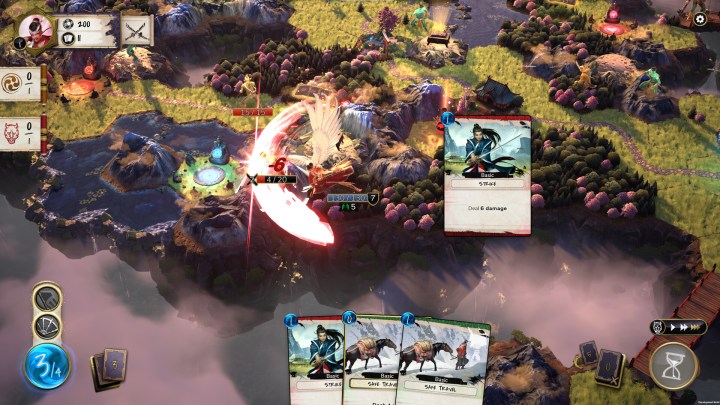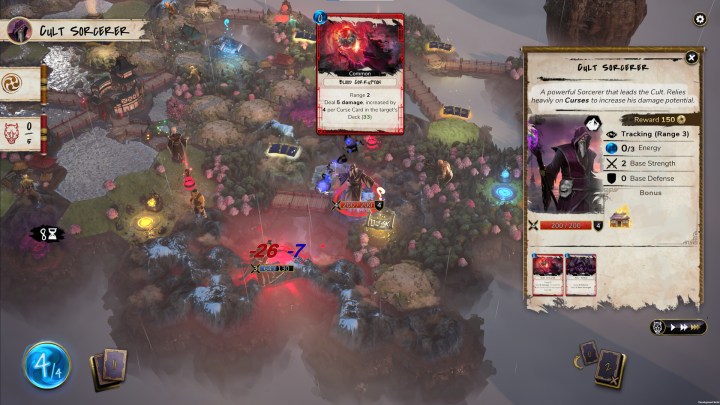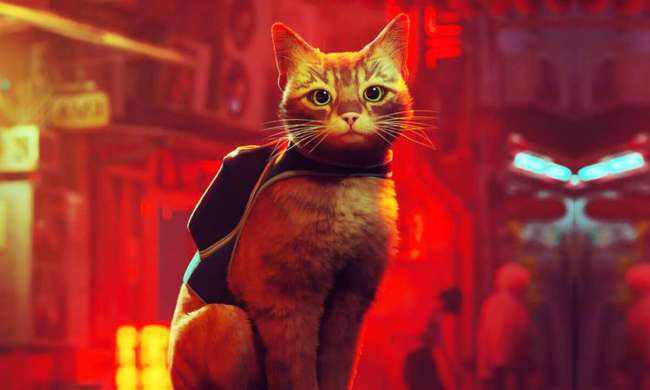Ever since Slay the Spire was released in 2017, deck-building has become a go-to genre for indie developers, right up there with roguelikes and Metroidvanias. Six years ago, it felt like a relatively untapped genre waiting to be torn apart. In 2023, the scene is much more bustling, which makes it a bit more difficult for something genuinely fresh to break through.
That’s why I’m especially impressed with Mahokenshi; the new samurai deck-builder is unlike any other card game I’ve played. Rather than making slight iterations to an established formula, it breaks some genre trends apart and remixes them into something that feels entirely new. The end result is a unique fusion of deck-building and strategy, carving another path for both genres to explore.
What’s the deal?
At first glance, Mahokenshi might look like a traditional tactics game. Players take control of a samurai battling their way through the Celestial Islands, a series of detailed, grid-like maps made of hexagonal tiles. On each turn, players get four ticks of energy that can be used to move and attack enemies scattered throughout the map. Each tile has its own specific effect, with something like a forest tile granting a bit of defense on a turn. Others offer buffs for that mission, like health or defense boosts.

What’s unique, though, is how naturally cards slot into that format. All attacks (as well as some defensive and special movement maneuvers) are handled through a hand of cards, which are dealt out at the start of each turn. When a mission begins, players only start with a deck of basic strikes and defense-granting dashes. New cards can be acquired by landing on deck spaces or shopping at village tiles, while they can be improved or removed at other spots. Each turn is a thoughtful juggling act where players have to decide how they want to spend their precious energy.
There are a lot of similarities to Slay the Spire here if you look hard enough, but entirely deconstructed and reassembled in clever ways. Missions, for instance, almost play out like an open-ended roguelike run. In an early one, I need to make my way north up a map to seal an oni-spawning summoning pit within 22 turns. As I move up the map, I come across a variety of tiles I can take detours to — so long as I’m confident I can reach my main objective in time. In something like Slay the Spire, these upgrade opportunities would materialize as paths you must choose between battles. Here, they’re all laid out on one traversable map and I’m given the power to make those choices freely as I juggle resource and objective management. Every mission, I’m essentially building a deck and character on the fly which will carry me through its ultimate challenge.
It all clicks quite well, though that song and dance can get difficult too. Mahokenshi hits a difficulty wall in its fourth main mission, where I have to stop a mage from rampaging five villages around a circular map. I spend the top of the mission gathering cards, upgrading my stats, and grabbing a relic. When I finally decide to move in and start my assault, I find that I’m overwhelmed by smaller enemies that force me to burn energy. As I do that, the boss loads my deck with several health-removing curse cards on each turn, rendering half of any given hand I’m dealt useless. It’s a moment where all that freedom starts to feel like a bit of a mixed blessing.

Mahokenshi does have an answer to difficulty spikes, fortunately. There’s a lot of permanent progression in addition to the one-off character-building within missions. There are four samurai classes in total and each can be leveled up by using them in missions to unlock better cards, relics, and perk-granting gear. Each mission has a set of objectives, both mandatory and optional, that grant a currency that’s used to upgrade a persistent skill tree too. Whenever I get stuck, I’m able to go back into an old mission and check off some objectives I missed to add some more tricks to my toolbox (like upgrading the damage of basic strike cards or getting more defense from forest tiles). The light RPG hooks are just another successful piece of its well-balanced genre gumbo.
I’ve yet to reach its conclusion, but I’m impressed by what Mahokenshi brings to the table. It’s a smart mix of strategy and deck-building that works way more than I figured it would at a glance. That makes for a fresh genre reinvention that has me eager to experiment with more card synergies. As long as indie developers keep dealing out creative ideas like this, I’ll stay at the table.
Mahokenshi is now available on PC.



